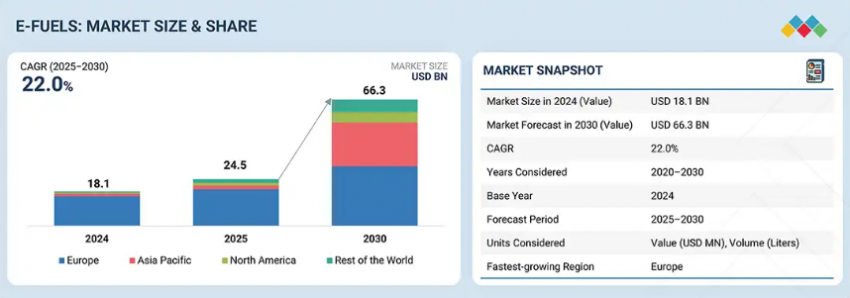The global e-fuels market is projected to reach USD 66.25 billion by 2030 from an estimated USD 24.49 billion in 2025, at a CAGR of 22.0%, during the forecast period. The e-fuels market is driven by increasing demand for sustainable alternatives to fossil fuels in hard-to-decarbonize sectors like aviation, shipping, and heavy-duty transport. Rising global regulations on emissions, such as carbon taxes and renewable fuel standards, push industries toward cleaner fuel solutions. Technological advancements in renewable energy, carbon capture, and Power-to-Liquid processes reduce production costs, making e-fuels more viable. The compatibility of e-fuels with existing infrastructure also accelerates adoption. Additionally, government incentives, corporate sustainability goals, and the push for energy security further fuel market growth.
By fuel type segment, the e-ammonia is expected to grow at the highest CAGR during the forecast period.
The e-ammonia segment is projected to grow at the highest CAGR in the e-fuels market due to its high energy density, carbon-free combustion, and versatility across multiple applications. It is gaining traction as a promising fuel for shipping and power generation, offering a zero-carbon alternative to traditional marine fuels. Advancements in green hydrogen production and ammonia synthesis technologies are improving their scalability. Additionally, growing investments in ammonia infrastructure and supportive regulatory frameworks aimed at decarbonizing industrial and maritime sectors are further propelling the rapid growth of the e-ammonia segment.
Download PDF Brochure @ https://www.marketsandmarkets.com/pdfdownloadNew.asp?id=7297145
By state segment, the liquid segment is expected to grow at the highest CAGR during the forecast period.
The liquid segment is expected to grow at the highest CAGR in the e-fuels market due to its ease of storage, handling, and transport using existing fuel infrastructure. Liquid e-fuels like e-diesel, e-gasoline, and e-kerosene offer drop-in compatibility with current internal combustion engines, making them ideal for aviation, maritime, and heavy transport sectors. Technological advancements in power-to-liquid processes and increasing investments in pilot and commercial-scale facilities enhance production capacity. Additionally, supportive regulatory frameworks and growing demand for sustainable liquid fuels are accelerating the adoption of this segment globally.
By region, Asia Pacific is expected to be the fastest-growing region during the forecast period.
Asia Pacific is poised to be the fastest-growing region in the e-fuels market due to rapid industrialization, rising energy demand, and increasing efforts to decarbonize hard-to-abate sectors like aviation and shipping. Countries like Japan, South Korea, India, and Australia are investing heavily in green hydrogen and renewable energy infrastructure, which are critical inputs for e-fuel production. Supportive policy frameworks, including net-zero targets and low-carbon fuel standards, are accelerating adoption. Additionally, regional collaborations and pilot projects are fostering technological innovation, while growing concerns over energy security and reducing reliance on imported fossil fuels further drive momentum in e-fuels deployment.
Key Market Players
Some of the major players in the e-fuels market are Saudi Arabian Oil Co. (Saudi Arabia), AUDI AG (Germany), Repsol (Spain), Sunfire SE (Germany), Electrochaea GmbH (Germany), Uniper SE (Germany), Ørsted A/S (Denmark), Yara (Norway), Perstorp (Sweden), HIF Global (US), and INFINIUM (US). These players adopt major strategies, including acquisitions, sales contracts, product launches, agreements, alliances, partnerships, and expansions.
Request Free Sample Report @ https://www.marketsandmarkets.com/requestsampleNew.asp?id=7297145

